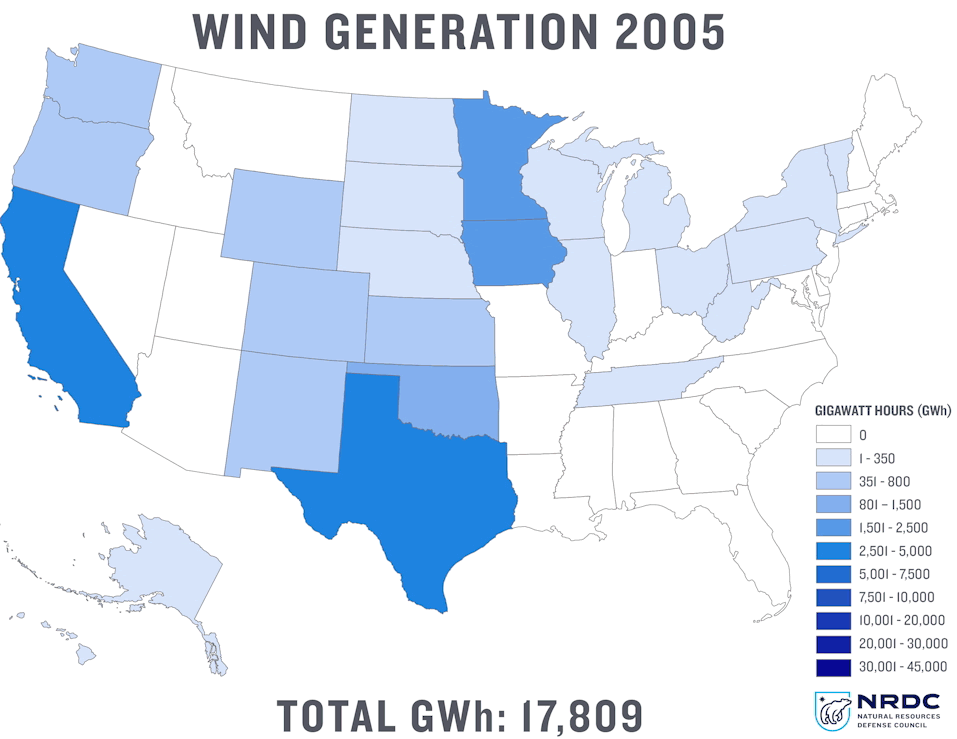Why the West Is Best (for Clean Energy)
Solar and wind power are booming in Colorado, Utah, and New Mexico. Here are some secrets to their success.

Invenergy’s Desert Green solar farm in Borrego Springs, California
Flat deserts, wide-open spaces, and seldom a cloud in sight—the inner American West has all the makings for generating renewable power. And despite a slow start, the region’s wind and solar industries are really taking off.
Take Colorado: By 2020, the Centennial State will require investor-owned energy utilities to generate 30 percent of their electricity from renewables, and it’s already more than halfway there. Now a member of the “10 percent and up club”—to which 12 states belong—Colorado got 14.2 percent of its electricity in 2015 from wind, up from just 1.5 percent in 2005.
Or look at Utah: In 2014, the dry and sunny Beehive State ranked 23rd in the nation for installed solar photovoltaic capacity. Last year, it leapt to 7th place.
And then there’s New Mexico, where Facebook just electrified the state’s economy by choosing the village of Los Lunas as the home of its newest data center—powered 100 percent by renewable energy.
So, what’s going on here?
First, they care.
Westerners themselves are helping to drive the boom. “Not only are the resources of highest quality in this part of the country, there is also a greater demand here,” says Noah Long, director of NRDC’s Western Energy Project. With 101,000 new residents just last year, Colorado has the highest population growth rate in the region and the second-highest in the nation. And more citizens and local governments are requesting cleaner power.


Colorado has actually been a renewable energy leader since 2004, when it passed its voter-led Renewable Energy Standard. This was the first time in U.S. history that such a standard was achieved at the ballot box rather than behind the state legislature’s doors. At the time, just about 2 percent of the state’s electricity was renewable; the standard required that Colorado’s largest utilities boost that to 3 percent by 2007 and then 10 percent by 2015. Now it’s shooting for 30.
Colorado is also no slacker when it comes to solar. In 2010 the state became the first to allow community solar farms and gardens, which let multiple households tap electricity from one communal solar plant, negating the need for one’s own pricey rooftop installation. It was so popular that the pilot subscriptions sold out within half an hour. This year, Colorado became home to Comanche Solar, which at 156 megawatts will be the largest solar facility east of the Rockies upon completion.
Second, they share.
The ability to send surplus wind and solar electricity across state lines is also encouraging clean energy’s growth in the region.
For instance, New Mexico currently has the ability to provide an estimated 1,000 times more clean energy than the state’s Public Service Company needs. So New Mexico sends much of its wind energy to California, whose populace, as you might imagine, has no problem consuming it. “California, Oregon, and Washington make up the lion’s share of demand for electricity across the West Coast,” Long confirms. Sunny California, in turn, leads the country in solar. Negotiations are currently underway to share its excess power with Oregon, Utah, and Wyoming.
Last, they made it cheap and easy.
The region’s shift from fossil fuels to sun and wind is possible largely because new technology has made those cleaner options more affordable. Tech advancements such as taller wind turbines with longer blades are allowing, for example, a 100-megawatt wind facility to run at up to 50 percent capacity across the West as opposed to its previous 30 percent. “If the turbine can produce more power, then you reduce the cost per unit of energy,” Long says.
More power is also coming from lower-speed wind, says Sarah Propst, the executive director of the Interwest Energy Alliance, a nonprofit trade association that connects renewable energy companies with nonprofits to develop new projects in Arizona, Colorado, Nevada, New Mexico, Utah, and Wyoming. With new tech nabbing some 20 to 30 percentage points more energy from turbines and construction costs remaining roughly the same, Long says the cost of wind energy plummeted 66 percent between 2009 and 2015. Prices for solar are also at an all-time low.
“Colorado is a wonderful success story thanks to a combination of policy and low prices that have led to significant wind and solar utility there,” Propst says. “They’ve really changed their culture since the early days.” In 2004, Xcel Energy, the state’s largest energy provider, challenged the state’s adoption of its Renewable Energy Standard. Since then, the Public Service Company of Colorado, an affiliate of Xcel that was heavily reliant on coal, has not only started producing and distributing more wind and solar, but helped spearhead the state’s community solar program. And in January, it proposed its Energy Future plan, which could more than double Colorado’s solar use over the next three years.
Looks like someone’s going to blow past its 30 percent target by 2020. And keep shining on from there.
This NRDC.org story is available for online republication by news media outlets or nonprofits under these conditions: The writer(s) must be credited with a byline; you must note prominently that the story was originally published by NRDC.org and link to the original; the story cannot be edited (beyond simple things such as grammar); you can’t resell the story in any form or grant republishing rights to other outlets; you can’t republish our material wholesale or automatically—you need to select stories individually; you can’t republish the photos or graphics on our site without specific permission; you should drop us a note to let us know when you’ve used one of our stories.

The Uinta Basin Railway Would Be a Bigger Carbon Bomb Than Willow
In Colorado’s High Desert, the Ute Mountain Ute Tribe Goes Solar
Albuquerque Is Wiring Up Millennials to Work With the Sun